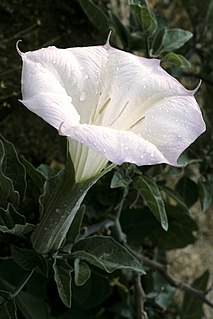
Datura is a genus of nine species of poisonous vespertine flowering plants belonging to the family Solanaceae. They are commonly known as thornapples or jimsonweeds but are also known as devil's trumpets. Other English common names include moonflower, devil's weed and hell's bells.

Datura stramonium, known by the common names thorn apple, jimsonweed or devil's snare, is a plant species in the nightshade family and Datura genus. Its likely origin was in Central America, and it has been introduced in many world regions. It is an aggressive invasive weed in temperate climates across the world.

Toxicodendron radicans, commonly known as eastern poison ivy or poison ivy, is an allergenic Asian and Eastern North American flowering plant in the genus Toxicodendron. The species is well known for causing urushiol-induced contact dermatitis, an itchy, irritating, and sometimes painful rash, in most people who touch it. The rash is caused by urushiol, a clear liquid compound in the plant's sap. The species is variable in its appearance and habit, and despite its common name, it is not a true ivy (Hedera), but rather a member of the cashew and pistachio family (Anacardiaceae). T. radicans is commonly eaten by many animals, and the seeds are consumed by birds, but poison ivy is most often thought of as an unwelcome weed. It is a different species from western poison ivy, Toxicodendron rydbergii, which has similar effects.

Commonly known as hellebores, the Eurasian genus Helleborus consists of approximately 20 species of herbaceous or evergreen perennial flowering plants in the family Ranunculaceae, within which it gave its name to the tribe of Helleboreae. Despite names such as "winter rose", "Christmas rose" and "Lenten rose", hellebores are not closely related to the rose family (Rosaceae). Many hellebore species are poisonous.

Datura wrightii, commonly known as sacred datura, is a poisonous perennial plant species and ornamental flower of the family Solanaceae native to southwestern North America. It is sometimes used as a hallucinogen. D. wrightii is classified as an anticholinergic deliriant.
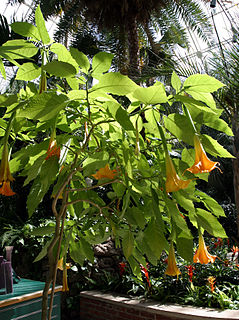
Brugmansia is a genus of seven species of flowering plants in the family Solanaceae. They are woody trees or shrubs, with pendulous flowers, and have no spines on their fruit. Their large, fragrant flowers give them their common name of angel's trumpets, a name sometimes used for the closely related genus Datura..

Asclepias incarnata, the swamp milkweed, rose milkweed, rose milkflower, swamp silkweed, or white Indian hemp, is a herbaceous perennial plant species native to North America. It grows in damp through wet soils and also is cultivated as a garden plant for its flowers, which attract butterflies and other pollinators with nectar. Like most other milkweeds, it has latex containing toxic chemicals, a characteristic that repels insects and other herbivorous animals.

Datura metel is a shrub-like annual or short-lived, shrubby perennial, commonly known in Europe as Indian Thornapple, Hindu Datura, or Metel and in the U.S.A as Devil's Trumpet. Datura metel is naturalised in all the warmer countries of the world - notably in India, where it is known by the ancient, Sanskrit-derived, Hindi name धतूरा (dhatūra) -from which the genus name Datura is derived, and in Tamil as ஊமத்தை (ūmattai). The plant is cultivated worldwide, both as an ornamental and for its medicinal properties, the latter being due to its tropane alkaloid content. Like its hardier and smaller-flowered relative Datura stramonium, it is now of widespread occurrence, although showing a preference for warmer climates and of more attractive appearance. Datura metel was first described by Carl Linnaeus in 1753, but few botanically correct illustrations were made until after the New World was settled. The original home of the plant is now known to have been somewhere in the Americas, probably the Greater Antilles. As late as 1992 it was still being claimed that the plant was "...native probably to the mountainous regions of Pakistan or Afghanistan westward..." While there now remains no doubt that the species originated in the New World, evidence is mounting that it was introduced to the Indian subcontinent - whether by human agency or some chance natural event is not known - at an early date preceding by far the arrival of the first European explorers in the Americas.

Datura innoxia, known as pricklyburr, recurved thorn-apple, downy thorn-apple, Indian-apple, lovache, moonflower, nacazcul, toloatzin, toloaxihuitl, tolguache or toloache, is a species of flowering plant in the family Solanaceae. It is more rarely called sacred datura, a common name which is applied more often to the closely related Datura wrightii. It is native to the Southwestern United States, Central and South America, and introduced in Africa, Asia, Australia and Europe. The scientific name is often cited as D. innoxia. When English botanist Philip Miller first described the species in 1768, he misspelled the Latin word innoxia (inoffensive) when naming it D. inoxia. The name Datura meteloides was for some time erroneously applied to some members of the species, but that name has now been abandoned.

Datura discolor, also called the desert thorn-apple, is an herbaceous annual plant native to the Sonoran Desert of western North America, where it grows in sandy soils and washes. All parts of the plant contain a mix of alkaloids that are potentially lethal when enough is ingested. Deaths from careless recreational use of Datura and related plants are frequently reported.
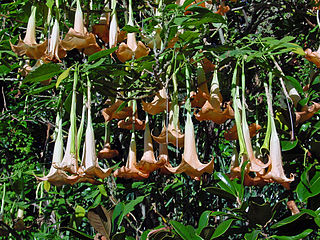
Brugmansia versicolor is a species of plant in the family Solanaceae, commonly known as “angel’s trumpets”. They are endemic to Ecuador. Since March 2014, they have been listed as Extinct in the Wild by the IUCN.

Datura leichhardtii is a species of thorn apple in the genus Datura. In 1844, Ludwig Leichhardt is said to have discovered this species in Australia. Ferdinand von Mueller gave it the name Datura leichhardtii when he published his first description of it in 1855.

Brugmansia suaveolens, Brazil's white angel trumpet, also known as angel's tears and snowy angel’s trumpet, is a species of flowering plant in the nightshade family Solanaceae, native to south eastern Brazil, but thought to be extinct in the wild. Like several other species of Brugmansia, it exists as an introduced species in areas outside its native range. It is a tender shrub or small tree with large semi-evergreen leaves and fragrant yellow or white trumpet-shaped flowers.
Datura quercifolia, commonly known as the oak-leaved thorn-apple is a small shrub in the genus Datura. It will grow equally well in dry or moist soils, provided that its need for high light levels is met, the plant only thriving in full sun.
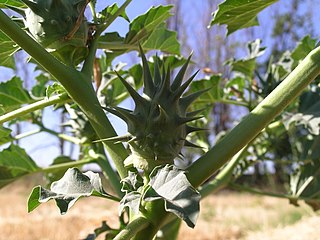
Datura ferox, commonly known as long spined thorn apple and fierce thornapple, as well as Angel's-trumpets, is a species of Datura. Like all such species, every part of the plant contains deadly toxins that can kill animals that ingest it. Its fruit, red-brown when ripe, has unusually long thorns or spikes.

Brugmansia arborea, the angel's trumpet, is a species of flowering plant in the family Solanaceae. The IUCN has classed Brugmansia arborea as Extinct in the Wild.

Ipomoea lacunosa, the whitestar, white morning-glory or pitted morningglory, is a species that belongs to the genus Ipomoea. In this genus most members are commonly referred to as "morning glories". The name for the genus, Ipomoea, has root in the Greek words ips and homoios, which translates to worm-like. This is a reference to the plant's vine-like growth. Lacunosa comes from a Latin word meaning air spaces, correlating with the venation of the leaves. Ipomoea lacunosa is native to the United States and grows annually. The flowers of this species are usually white and smaller than most other morning glories.

Nolina microcarpa is a species of flowering plant in the asparagus family known by the common names sacahuista and palmilla. Like other species of Nolina, it may be called beargrass. It is native to northern Mexico and the southwestern United States in Arizona and New Mexico. It does occur in the southwestern corner of Utah, where it has a limited distribution on Navajo Sandstone, but reports of it occurring in Texas may be in error.
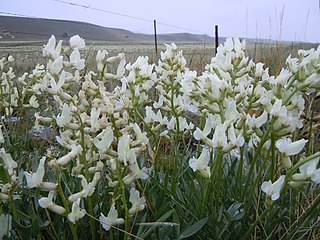
Oxytropis sericea is a species of flowering plant in the legume family known by the common names white locoweed, white point-vetch, whitepoint crazyweed, and silky crazyweed. It is native to western North America from Yukon and British Columbia south through the Pacific Northwest, the Rocky Mountains, and the Great Plains.

Sesbania punicea is an ornamental shrub with reddish-orange flowers. It has deciduous leaves and grows to a height of 15 feet. This plant has a high demand for water, and thrives in swamps or wet areas. It requires a mildly acidic soil, with a pH between 6.1 and 6.5.



















